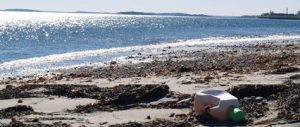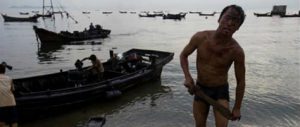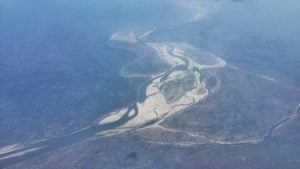Callum Roberts is professor of marine conservation at the University of York in the United Kingdom. For a decade, he has campaigned for better protection of ocean life, leading directly to the creation in 2010 of the world's first network of protected high seas. His new book is Ocean of Life (see our review here).
Caspar Henderson: In Ocean of Life you outline around dozen major stresses on the world's oceans resulting from human behaviour. It's a formidable list, including overfishing, changes in ocean currents and temperature, sea-level rise, acidification, dead zones, pollution and plastic, noise and disease. What do you hope to achieve by describing them all in one book?
Callum Roberts: My previous book, The Unnatural History of the Sea, focused on overfishing. The severity of the problem is now widely recognised. And I now think that a clear solution is in sight. We need to fish less, using the best available technologies to minimise our impacts on the sea. Such measures, if implemented, will lead to a recovery of global fisheries. It’s as simple as that. Overfishing is the world’s most soluble environmental problem.
One of the points I wanted to make in this book is that we should not look at overfishing in isolation. Studies from all over the world show that overfishing is exacerbating other marine problems, ranging from pollution to algal overgrowth of coral reefs. People do recognise that there are interactions which increase stresses. But nowhere, as far as I can see, has there been a significant attempt to look at all these stresses together and see how they interact globally. That is what I have tried to do.
There are some 10 to a dozen major anthropogenic stresses on the oceans, and there are links between them. For example, global warming is leading to changes to ocean currents – changing the pattern of heat distribution on the globe, altering the patterns of salinity, evaporation and precipitation. Other changes are less directly linked. Ocean acidification, which is caused by the increase in carbon dioxide in the atmosphere, is not directly linked to changes in ocean currents. Or at least the links are very minor.
The most obvious links, perhaps, are those between pollution and overfishing, which in combination can cause eutrophication, the excessive growth of plankton. Eutrophication is in turn strongly linked to the frequency of harmful toxic algal blooms. And these toxic blooms can in turn impact fisheries and human health – either by making fish and shellfish that eat them too toxic for humans, or by killing fish directly and so diminishing catches.
These factors also link directly to the creation of dead zones in which an excessive production of biomass rots in absence of animals to eat it, and uses up most or all of the oxygen in the water.
CH: What do people need to know about ocean acidification?
CR: Many people now understand that acidification, which results from excess carbon dioxide in the atmosphere dissolving into seawater, affects coral reefs. Acidification makes it much harder for corals to extract calcium carbonate from seawater and secrete it as skeletons. What is less well understood, however, is that a great variety of other organisms that make calcareous skeletons are also likely to be affected and, further, the rate and impact of acidification is not going to be even across the globe: its effects are going to be felt soonest in the polar regions. We are already seeing the effects in these higher latitudes regions, with potentially grave consequences for the entire food chain.
The last time the oceans really acidified anything like this fast was about 55 million years ago. At that time, there was runaway global warming already happening, and the oceans gradually acidified as carbon-dioxide levels rose over a period of about 10,000 years. That was a big spike on a geological time frame. By contrast, human emissions of carbon dioxide are expected to effect a similar change in just 200 years.
CH: What about plastics?
CR: Plastics have risen in public awareness largely as a result of foolish albatrosses that cannot distinguish plastic from food. They feed their chicks this junk-food diet, and it is just shocking to see how much plastic can be crammed into an albatross chick before it eventually keels over and dies. These images have caused widespread concern and have stimulated people to go out into the middle of ocean gyres and start working out what is actually there.
It turns out that not many animals consume plastic to the degree of actually killing themselves as albatrosses do. Most animals consume only small particles which, by and large, pass through the gut. The problem is that those plastic particles, which we only started to introduce into the ocean on a large scale five or six decades ago, are getting smaller over time.
One reason for this is that larger pieces break into smaller ones over time. Another reason is that humans are releasing micro-plastics in ever greater quantities into the environment. Micro-plastics are in the synthetic fibres in washing machine water – fine piece of nylon, polyester and other fabrics which pass straight through the filters at sewage farms and then out to sea. They’re also in facial scrubs, exfoliating face creams and all sorts of other products, and these are in the range for consumption by the tiniest zooplankton. This is particularly worrying because micro-plastic is not harmless “roughage”. Rather, it attracts and absorbs toxic chemicals, which are then consumed by plankton and passed up the food chain.
In the past, polychlorinated bisphenyl – or PCBs – were a concern. Their production has now been greatly restricted. Today, however, we're seeing widespread use of Bisphenol A and brominated flame retardants, or BFRs. BFRs, in particular, are everywhere. The computers on our desks are full of them. The chair I'm sitting on is full of them. These are absorbed through the food web into the body and passed to children through mother’s milk. And we're really not sure what their effects of these are. They could be behind quite a number of disorders, particularly neurological birth defects. High levels of these contaminants could end up causing problems of brain development. There’s a lot of uncertainty here but the risk is evident.
CH: Despite the enormity of these and other challenges, you are remarkably optimistic! You insist in your book that citizens, businesses and nations can chart a more constructive path, reducing present impacts and even restoring some of the richness of ocean so that once again we have resilient and vibrant marine ecosystems worldwide. I want to believe this but I'm not sure I do.
CR: I didn’t want to downplay the problems. We have very little chance of bringing some of the most destructive drivers of change under control within the next 10 or 20 years. One of the greatest of those drivers is the growth in human population and, in particular, the emergence of an additional three billion people, many of them in China, into the high-consuming, resource-hungry global middle class.
And then we’ve got the global emissions of greenhouse gases, which are for now directly linked to population size and affluence. Dealing with those will require serious long-term commitment from all of the world's governments. So we have a problem! The rate of sea-level rise has been tracking along the maximum that was predicted in 1992. We are seeing the worst-case scenario unfolding in terms of greenhouse-gas emissions and an almost complete failure so far to do anything very meaningful about them.
Still, in a book about how the oceans are changing I've assumed – I've had to assume – that we will somehow tackle these challenges, because we have to. The ultimate outcome of not tackling them is, unquestionably, disaster.
Given that that is a work of some decades, I then scratched my head to think about what can we do in the here and now that is going to give ocean life and ecosystems the best chance of making it through the difficult times ahead. This led to some deep thinking about how it is that multiple stresses interact, and what to do when they do. And the take-home message is that, if we mitigate at least some of those stresses, then the positive outcomes can be greater than expected.
CH: You advocate, in particular, the creation of marine protected areas, or MPAs, on a very large scale, covering as much as a third of the total global ocean.
CR: Virtually everywhere that people have implemented MPAs, the results have been extremely positive and remarkably quick. Within five to 10 years, you tend to see a resurgence of those species surviving within the protected areas that have short lives and high reproduction rates. Over slightly longer periods, longer term effects can kick in. You can see phase-shifts back from urchin barrens to kelp forests within just a few decades. You can see the rebuilding of reef habitats and the gradual emergence of populations dominated by bigger and older animals, which produce many more offspring than smaller individuals.
The science shows that the benefits of a new MPA continue to rise for several decades. And, crucially, the benefits spread to areas outside the reserves. Offspring spill over into surrounding fishing grounds as juveniles and adults move from high density to lower density conditions. This is the “fountain” effect I talk about in the book.
A century ago, the areas that had not been fished outnumbered those that had been by a hundred to one. Now the ratio is reversed. Restoring meaningful level of abundance requires that we place very large areas under protection. The United Nations has got behind a goal of 10% of world oceans but this is much too low. The science, which is still evolving but is undoubtedly becoming more robust, suggests that to restore ecological function we need to protect between 20% and 40% of the whole.
Another essential point to understand is that we cannot manage the marine environment as we do the terrestrial one. Quite often you hear people comparing fishing to farming. This is a false analogy. In farming we're able to mitigate the consequences of our impact through detailed husbandry. But the sea is a wild place, beyond our control in those mechanistic ways.
CH: Can you give some more examples of initiatives and trends in the right direction?
CR: One of the most positive indicators is the reduction of concentrations of DDT in marine mammals over the last 20 to 30 years. And there are good examples of how quickly coastal waters and bays can recover once we stop releasing large amounts of sewage into them. You see this in Hawaii, where for a long time the main sewage outlet from the city went directly into the bay, which became horribly overgrown with seaweed. The lesson from all these examples and others is clear: once we really decide to get to grips with ocean problems we can see palpable benefits within our lifetimes.
But there is another point I really want to stress, and that is that our window of opportunity – the window in which we can make a real difference – is shrinking. The longer we wait, the more severe the problems will be and the fewer options we will have to reverse them.
Caspar Henderson is a writer and journalist on environmental affairs. He tweets at @casparhenderson.



